Corporate Finance Report: Project Analysis, Merger Types, and Motives
VerifiedAdded on 2023/01/23
|10
|1801
|56
Report
AI Summary
This report delves into key aspects of corporate finance, providing a comprehensive analysis of project evaluation and mergers. It begins with an introduction to corporate finance, emphasizing its role in investment decisions, financing, and capital restructuring. The report then explores project viability through the calculation and interpretation of Net Present Value (NPV) and Payback Period for different projects, including detailed calculations and interpretations. It further examines mergers, defining them as the combination of two companies, and categorizes different types of mergers such as horizontal, vertical, market-extension, product-extension, and conglomerate mergers. The report also discusses the motives behind mergers, including synergy creation, diversification, boosted growth, increased market share, and enhanced financial capabilities. Finally, it provides a conclusion summarizing the key findings and a list of references.
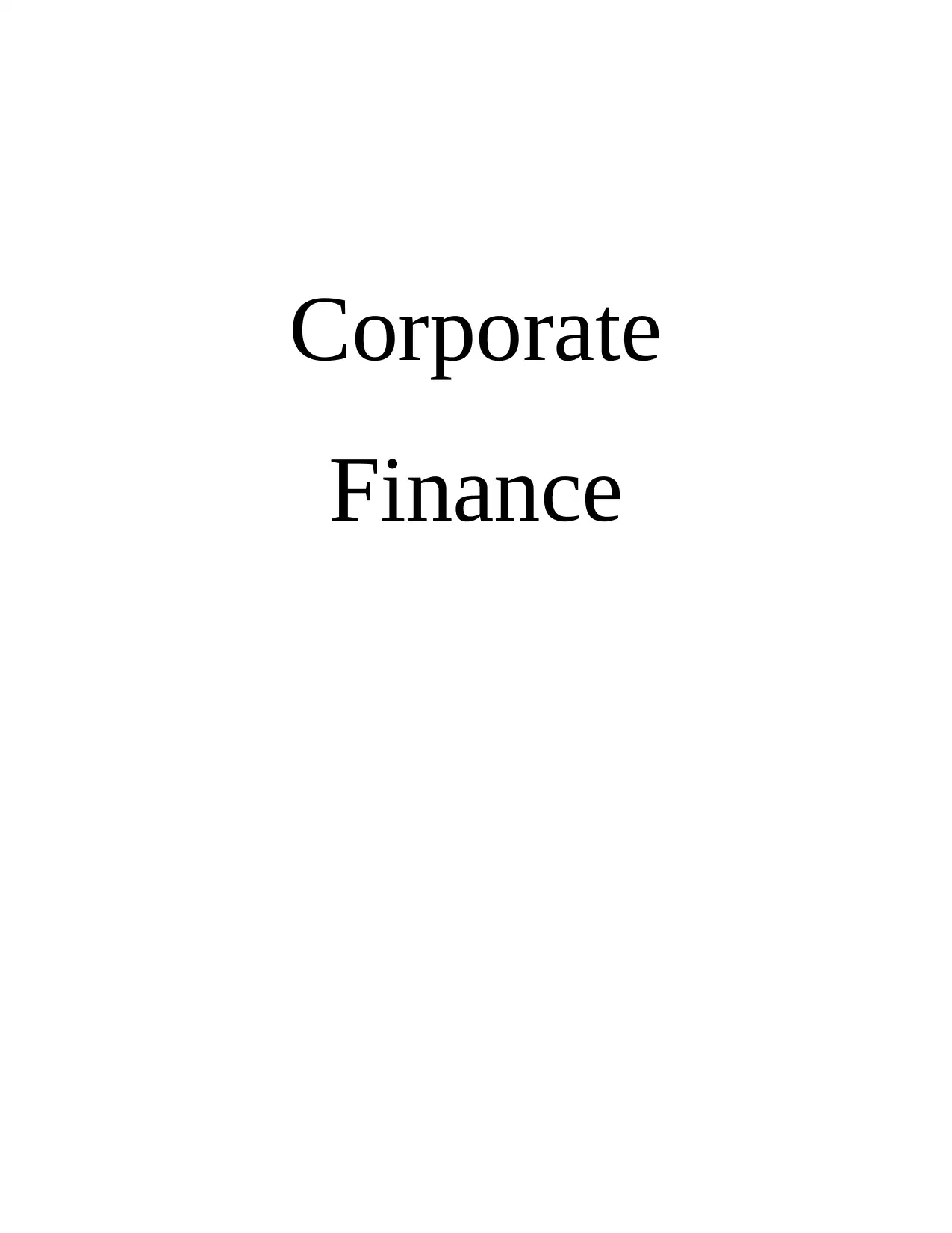
Corporate
Finance
Finance
Paraphrase This Document
Need a fresh take? Get an instant paraphrase of this document with our AI Paraphraser
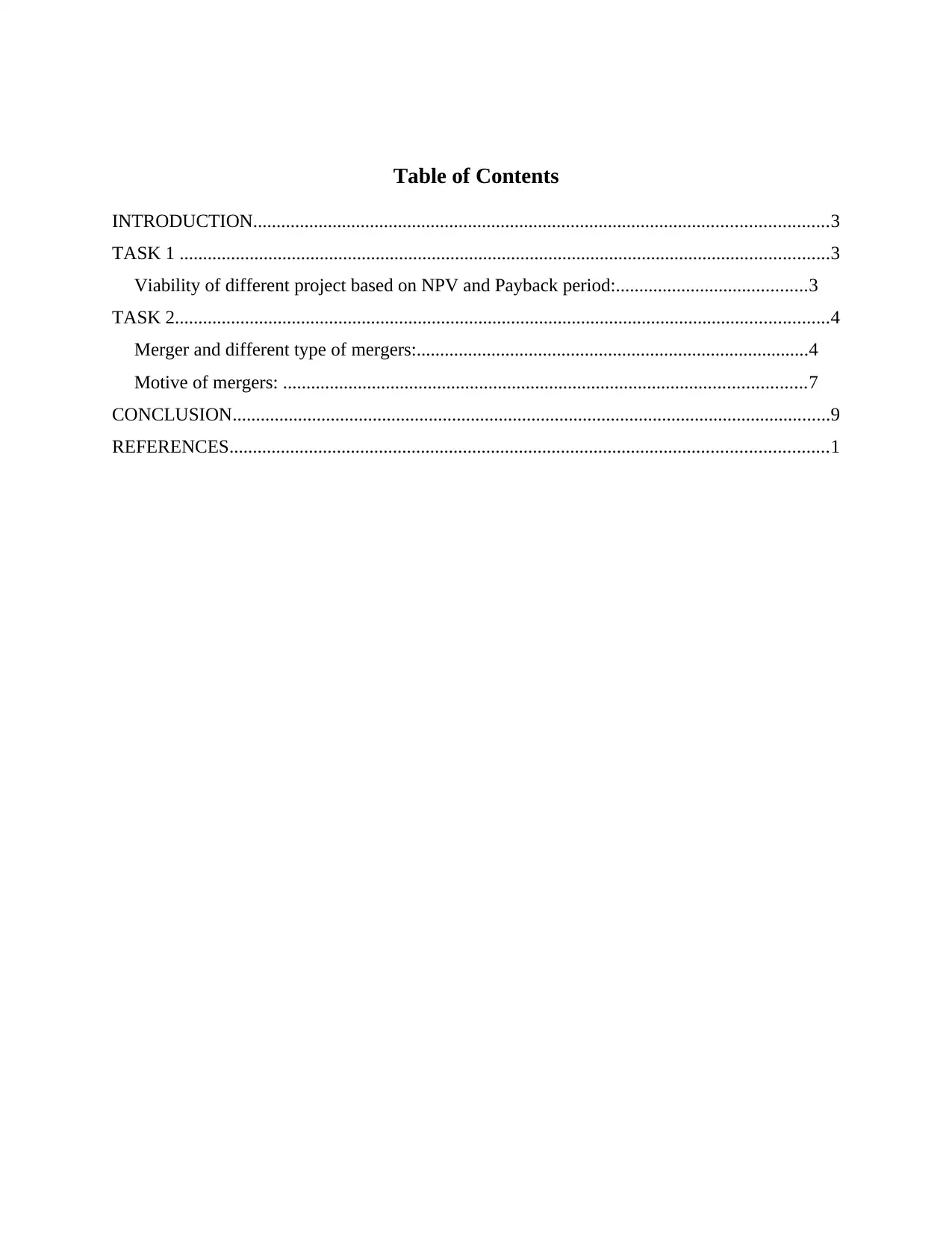
Table of Contents
INTRODUCTION...........................................................................................................................3
TASK 1 ...........................................................................................................................................3
Viability of different project based on NPV and Payback period:.........................................3
TASK 2............................................................................................................................................4
Merger and different type of mergers:....................................................................................4
Motive of mergers: ................................................................................................................7
CONCLUSION................................................................................................................................9
REFERENCES................................................................................................................................1
INTRODUCTION...........................................................................................................................3
TASK 1 ...........................................................................................................................................3
Viability of different project based on NPV and Payback period:.........................................3
TASK 2............................................................................................................................................4
Merger and different type of mergers:....................................................................................4
Motive of mergers: ................................................................................................................7
CONCLUSION................................................................................................................................9
REFERENCES................................................................................................................................1
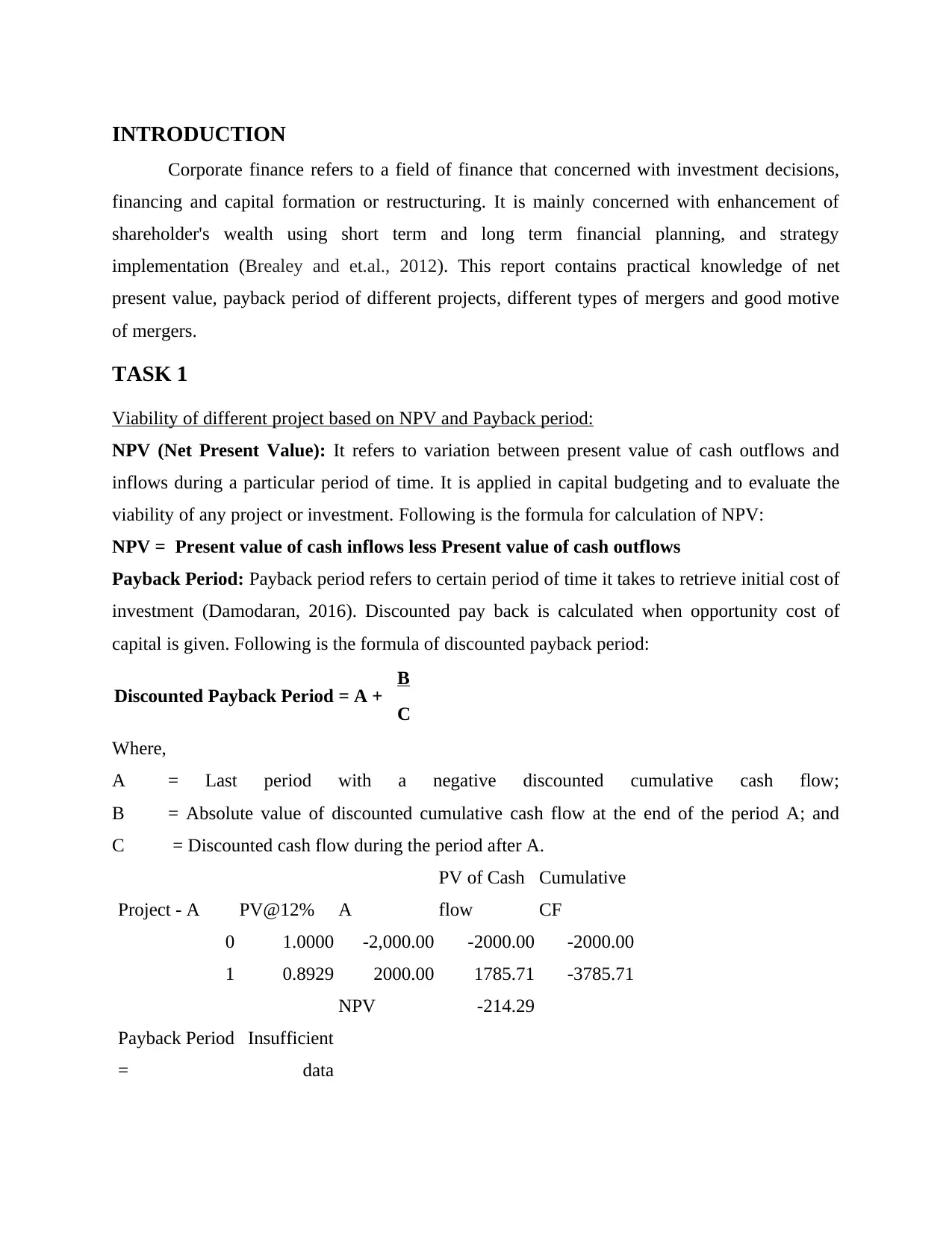
INTRODUCTION
Corporate finance refers to a field of finance that concerned with investment decisions,
financing and capital formation or restructuring. It is mainly concerned with enhancement of
shareholder's wealth using short term and long term financial planning, and strategy
implementation (Brealey and et.al., 2012). This report contains practical knowledge of net
present value, payback period of different projects, different types of mergers and good motive
of mergers.
TASK 1
Viability of different project based on NPV and Payback period:
NPV (Net Present Value): It refers to variation between present value of cash outflows and
inflows during a particular period of time. It is applied in capital budgeting and to evaluate the
viability of any project or investment. Following is the formula for calculation of NPV:
NPV = Present value of cash inflows less Present value of cash outflows
Payback Period: Payback period refers to certain period of time it takes to retrieve initial cost of
investment (Damodaran, 2016). Discounted pay back is calculated when opportunity cost of
capital is given. Following is the formula of discounted payback period:
Discounted Payback Period = A + B
C
Where,
A = Last period with a negative discounted cumulative cash flow;
B = Absolute value of discounted cumulative cash flow at the end of the period A; and
C = Discounted cash flow during the period after A.
Project - A PV@12% A
PV of Cash
flow
Cumulative
CF
0 1.0000 -2,000.00 -2000.00 -2000.00
1 0.8929 2000.00 1785.71 -3785.71
NPV -214.29
Payback Period
=
Insufficient
data
Corporate finance refers to a field of finance that concerned with investment decisions,
financing and capital formation or restructuring. It is mainly concerned with enhancement of
shareholder's wealth using short term and long term financial planning, and strategy
implementation (Brealey and et.al., 2012). This report contains practical knowledge of net
present value, payback period of different projects, different types of mergers and good motive
of mergers.
TASK 1
Viability of different project based on NPV and Payback period:
NPV (Net Present Value): It refers to variation between present value of cash outflows and
inflows during a particular period of time. It is applied in capital budgeting and to evaluate the
viability of any project or investment. Following is the formula for calculation of NPV:
NPV = Present value of cash inflows less Present value of cash outflows
Payback Period: Payback period refers to certain period of time it takes to retrieve initial cost of
investment (Damodaran, 2016). Discounted pay back is calculated when opportunity cost of
capital is given. Following is the formula of discounted payback period:
Discounted Payback Period = A + B
C
Where,
A = Last period with a negative discounted cumulative cash flow;
B = Absolute value of discounted cumulative cash flow at the end of the period A; and
C = Discounted cash flow during the period after A.
Project - A PV@12% A
PV of Cash
flow
Cumulative
CF
0 1.0000 -2,000.00 -2000.00 -2000.00
1 0.8929 2000.00 1785.71 -3785.71
NPV -214.29
Payback Period
=
Insufficient
data
⊘ This is a preview!⊘
Do you want full access?
Subscribe today to unlock all pages.

Trusted by 1+ million students worldwide
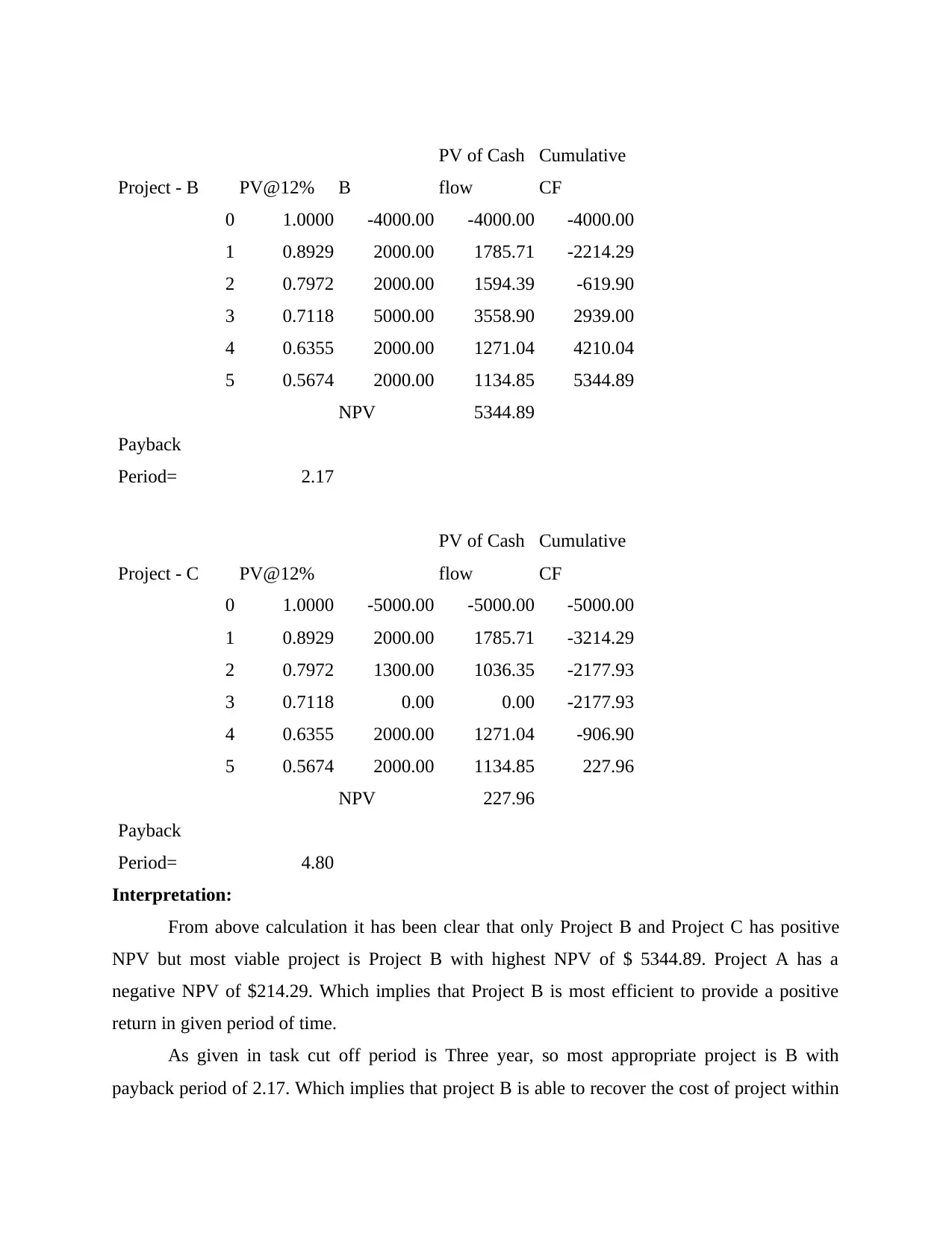
Project - B PV@12% B
PV of Cash
flow
Cumulative
CF
0 1.0000 -4000.00 -4000.00 -4000.00
1 0.8929 2000.00 1785.71 -2214.29
2 0.7972 2000.00 1594.39 -619.90
3 0.7118 5000.00 3558.90 2939.00
4 0.6355 2000.00 1271.04 4210.04
5 0.5674 2000.00 1134.85 5344.89
NPV 5344.89
Payback
Period= 2.17
Project - C PV@12%
PV of Cash
flow
Cumulative
CF
0 1.0000 -5000.00 -5000.00 -5000.00
1 0.8929 2000.00 1785.71 -3214.29
2 0.7972 1300.00 1036.35 -2177.93
3 0.7118 0.00 0.00 -2177.93
4 0.6355 2000.00 1271.04 -906.90
5 0.5674 2000.00 1134.85 227.96
NPV 227.96
Payback
Period= 4.80
Interpretation:
From above calculation it has been clear that only Project B and Project C has positive
NPV but most viable project is Project B with highest NPV of $ 5344.89. Project A has a
negative NPV of $214.29. Which implies that Project B is most efficient to provide a positive
return in given period of time.
As given in task cut off period is Three year, so most appropriate project is B with
payback period of 2.17. Which implies that project B is able to recover the cost of project within
PV of Cash
flow
Cumulative
CF
0 1.0000 -4000.00 -4000.00 -4000.00
1 0.8929 2000.00 1785.71 -2214.29
2 0.7972 2000.00 1594.39 -619.90
3 0.7118 5000.00 3558.90 2939.00
4 0.6355 2000.00 1271.04 4210.04
5 0.5674 2000.00 1134.85 5344.89
NPV 5344.89
Payback
Period= 2.17
Project - C PV@12%
PV of Cash
flow
Cumulative
CF
0 1.0000 -5000.00 -5000.00 -5000.00
1 0.8929 2000.00 1785.71 -3214.29
2 0.7972 1300.00 1036.35 -2177.93
3 0.7118 0.00 0.00 -2177.93
4 0.6355 2000.00 1271.04 -906.90
5 0.5674 2000.00 1134.85 227.96
NPV 227.96
Payback
Period= 4.80
Interpretation:
From above calculation it has been clear that only Project B and Project C has positive
NPV but most viable project is Project B with highest NPV of $ 5344.89. Project A has a
negative NPV of $214.29. Which implies that Project B is most efficient to provide a positive
return in given period of time.
As given in task cut off period is Three year, so most appropriate project is B with
payback period of 2.17. Which implies that project B is able to recover the cost of project within
Paraphrase This Document
Need a fresh take? Get an instant paraphrase of this document with our AI Paraphraser
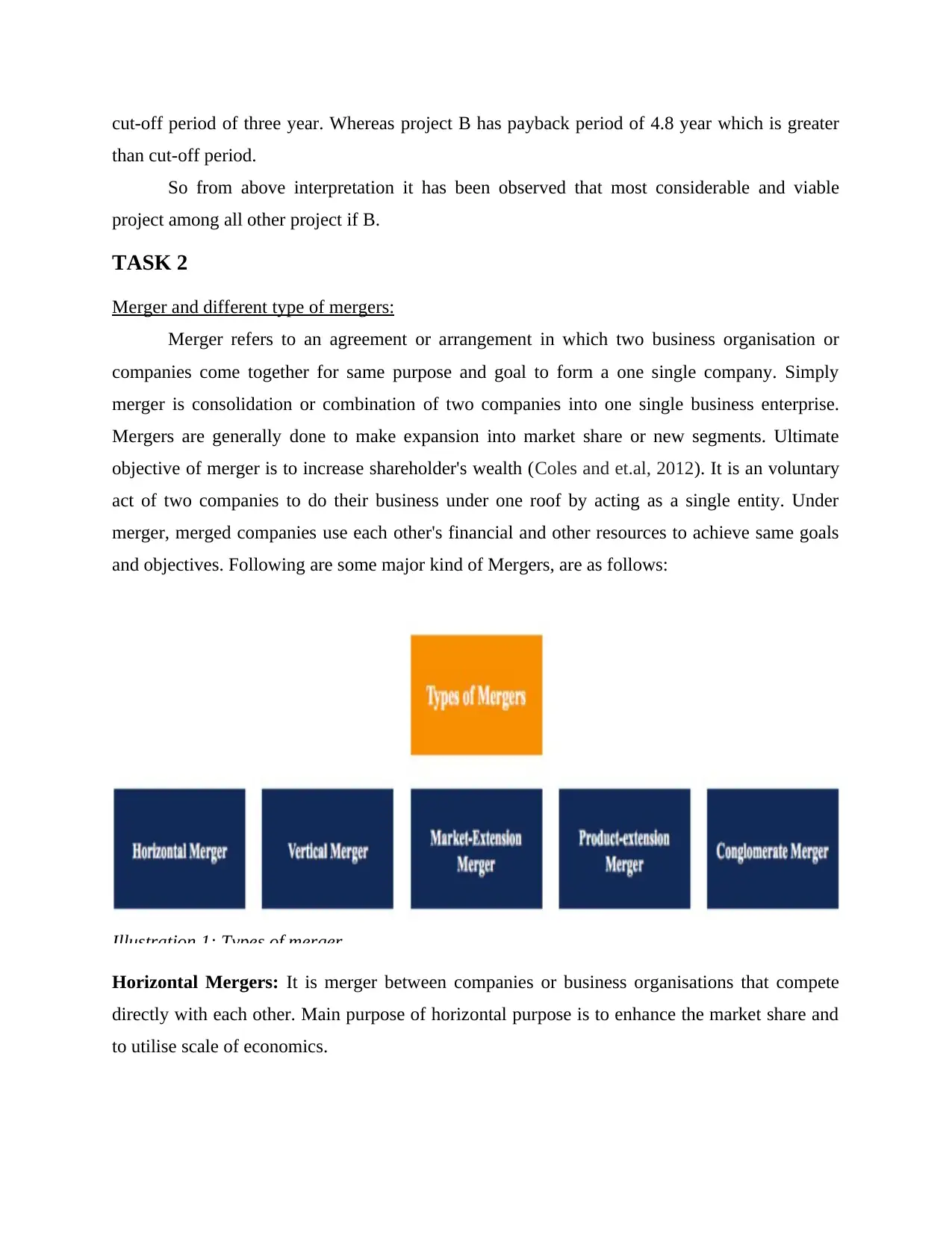
cut-off period of three year. Whereas project B has payback period of 4.8 year which is greater
than cut-off period.
So from above interpretation it has been observed that most considerable and viable
project among all other project if B.
TASK 2
Merger and different type of mergers:
Merger refers to an agreement or arrangement in which two business organisation or
companies come together for same purpose and goal to form a one single company. Simply
merger is consolidation or combination of two companies into one single business enterprise.
Mergers are generally done to make expansion into market share or new segments. Ultimate
objective of merger is to increase shareholder's wealth (Coles and et.al, 2012). It is an voluntary
act of two companies to do their business under one roof by acting as a single entity. Under
merger, merged companies use each other's financial and other resources to achieve same goals
and objectives. Following are some major kind of Mergers, are as follows:
Illustration 1: Types of merger
Horizontal Mergers: It is merger between companies or business organisations that compete
directly with each other. Main purpose of horizontal purpose is to enhance the market share and
to utilise scale of economics.
than cut-off period.
So from above interpretation it has been observed that most considerable and viable
project among all other project if B.
TASK 2
Merger and different type of mergers:
Merger refers to an agreement or arrangement in which two business organisation or
companies come together for same purpose and goal to form a one single company. Simply
merger is consolidation or combination of two companies into one single business enterprise.
Mergers are generally done to make expansion into market share or new segments. Ultimate
objective of merger is to increase shareholder's wealth (Coles and et.al, 2012). It is an voluntary
act of two companies to do their business under one roof by acting as a single entity. Under
merger, merged companies use each other's financial and other resources to achieve same goals
and objectives. Following are some major kind of Mergers, are as follows:
Illustration 1: Types of merger
Horizontal Mergers: It is merger between companies or business organisations that compete
directly with each other. Main purpose of horizontal purpose is to enhance the market share and
to utilise scale of economics.
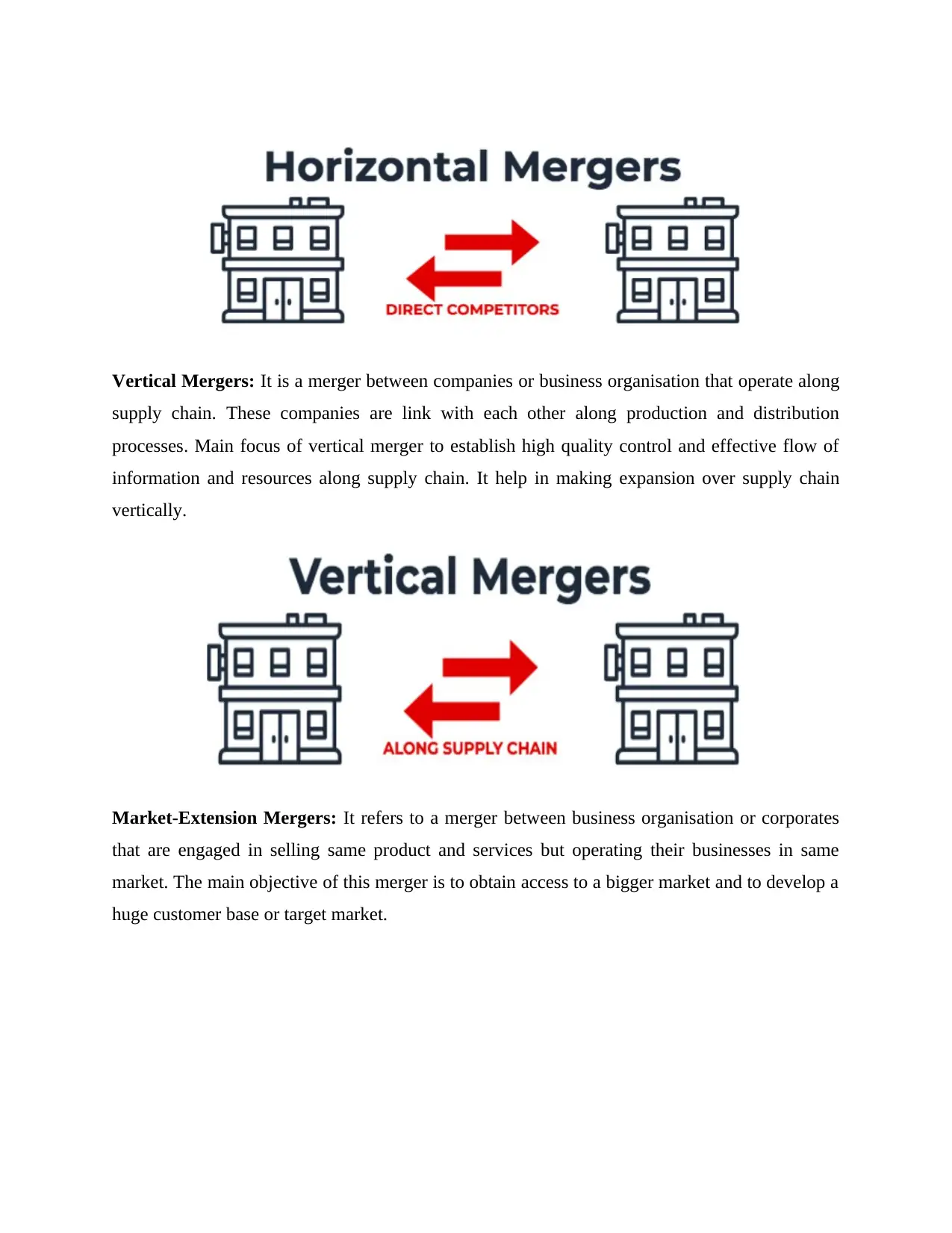
Vertical Mergers: It is a merger between companies or business organisation that operate along
supply chain. These companies are link with each other along production and distribution
processes. Main focus of vertical merger to establish high quality control and effective flow of
information and resources along supply chain. It help in making expansion over supply chain
vertically.
Market-Extension Mergers: It refers to a merger between business organisation or corporates
that are engaged in selling same product and services but operating their businesses in same
market. The main objective of this merger is to obtain access to a bigger market and to develop a
huge customer base or target market.
supply chain. These companies are link with each other along production and distribution
processes. Main focus of vertical merger to establish high quality control and effective flow of
information and resources along supply chain. It help in making expansion over supply chain
vertically.
Market-Extension Mergers: It refers to a merger between business organisation or corporates
that are engaged in selling same product and services but operating their businesses in same
market. The main objective of this merger is to obtain access to a bigger market and to develop a
huge customer base or target market.
⊘ This is a preview!⊘
Do you want full access?
Subscribe today to unlock all pages.

Trusted by 1+ million students worldwide

Product-Extension Mergers: It is a merger between companies and business organisations that
are engaged in selling related product and services, and operating their business in same market.
By applying this merger, merged company can combine their products and enhance its reach to
more customers (Vernimmen and et.al, 2014). Here product and services of both companies are
not same but they are related with each other directly or indirectly. Main objective of this merger
is to proper utilisation of similar supply chain, distribution channel and related production
processes.
Conglomerate Mergers: It is a merger between business organisation or corporates that are
absolutely unrelated. This merger is further classified as mixed and pure.
Pure conglomerate merger: It includes companies which are totally unrelated and these
companies are operating in different markets.
Mixed conglomerate merger: It includes companies which wants to expand their target
market or line of product.
are engaged in selling related product and services, and operating their business in same market.
By applying this merger, merged company can combine their products and enhance its reach to
more customers (Vernimmen and et.al, 2014). Here product and services of both companies are
not same but they are related with each other directly or indirectly. Main objective of this merger
is to proper utilisation of similar supply chain, distribution channel and related production
processes.
Conglomerate Mergers: It is a merger between business organisation or corporates that are
absolutely unrelated. This merger is further classified as mixed and pure.
Pure conglomerate merger: It includes companies which are totally unrelated and these
companies are operating in different markets.
Mixed conglomerate merger: It includes companies which wants to expand their target
market or line of product.
Paraphrase This Document
Need a fresh take? Get an instant paraphrase of this document with our AI Paraphraser
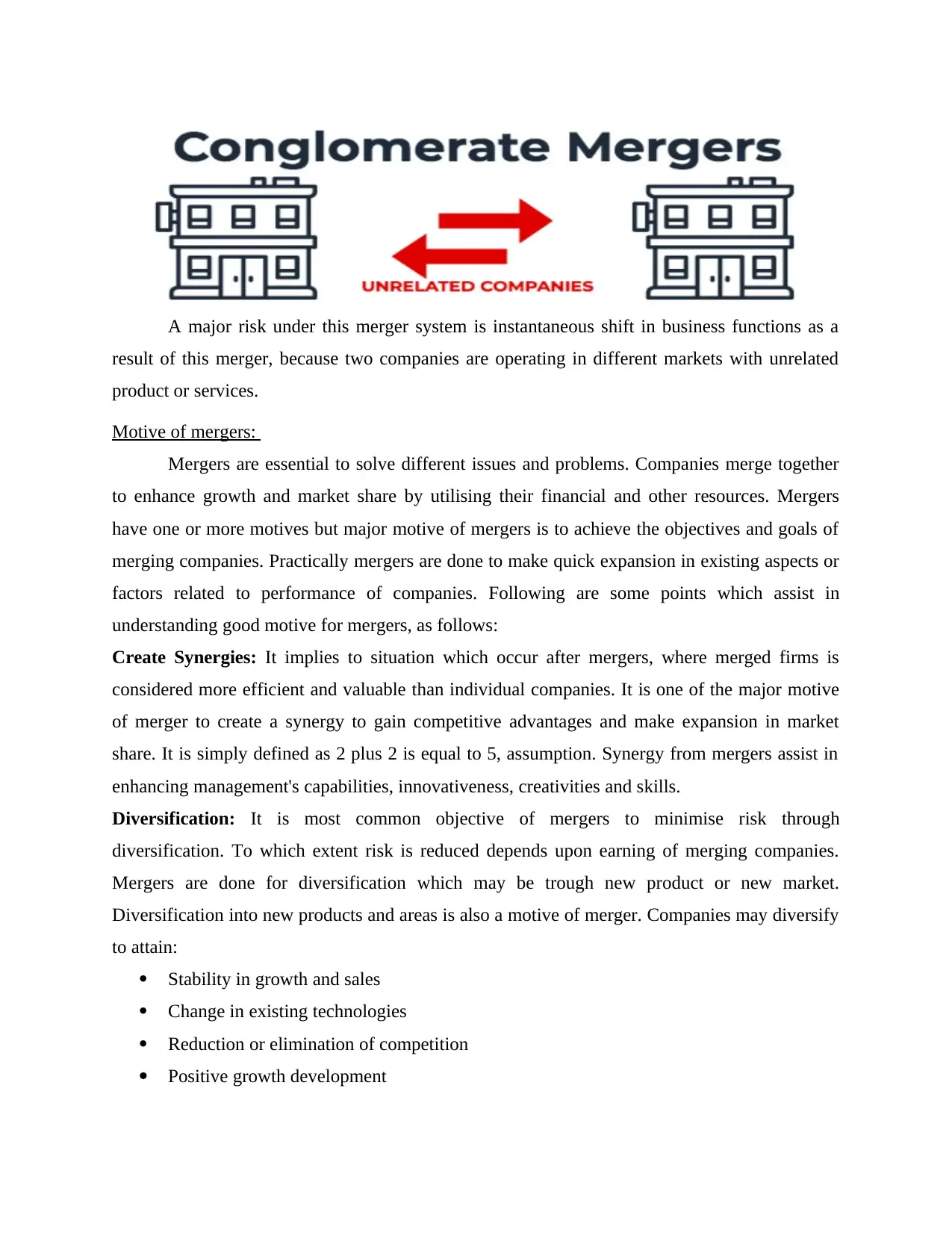
A major risk under this merger system is instantaneous shift in business functions as a
result of this merger, because two companies are operating in different markets with unrelated
product or services.
Motive of mergers:
Mergers are essential to solve different issues and problems. Companies merge together
to enhance growth and market share by utilising their financial and other resources. Mergers
have one or more motives but major motive of mergers is to achieve the objectives and goals of
merging companies. Practically mergers are done to make quick expansion in existing aspects or
factors related to performance of companies. Following are some points which assist in
understanding good motive for mergers, as follows:
Create Synergies: It implies to situation which occur after mergers, where merged firms is
considered more efficient and valuable than individual companies. It is one of the major motive
of merger to create a synergy to gain competitive advantages and make expansion in market
share. It is simply defined as 2 plus 2 is equal to 5, assumption. Synergy from mergers assist in
enhancing management's capabilities, innovativeness, creativities and skills.
Diversification: It is most common objective of mergers to minimise risk through
diversification. To which extent risk is reduced depends upon earning of merging companies.
Mergers are done for diversification which may be trough new product or new market.
Diversification into new products and areas is also a motive of merger. Companies may diversify
to attain:
Stability in growth and sales
Change in existing technologies
Reduction or elimination of competition
Positive growth development
result of this merger, because two companies are operating in different markets with unrelated
product or services.
Motive of mergers:
Mergers are essential to solve different issues and problems. Companies merge together
to enhance growth and market share by utilising their financial and other resources. Mergers
have one or more motives but major motive of mergers is to achieve the objectives and goals of
merging companies. Practically mergers are done to make quick expansion in existing aspects or
factors related to performance of companies. Following are some points which assist in
understanding good motive for mergers, as follows:
Create Synergies: It implies to situation which occur after mergers, where merged firms is
considered more efficient and valuable than individual companies. It is one of the major motive
of merger to create a synergy to gain competitive advantages and make expansion in market
share. It is simply defined as 2 plus 2 is equal to 5, assumption. Synergy from mergers assist in
enhancing management's capabilities, innovativeness, creativities and skills.
Diversification: It is most common objective of mergers to minimise risk through
diversification. To which extent risk is reduced depends upon earning of merging companies.
Mergers are done for diversification which may be trough new product or new market.
Diversification into new products and areas is also a motive of merger. Companies may diversify
to attain:
Stability in growth and sales
Change in existing technologies
Reduction or elimination of competition
Positive growth development
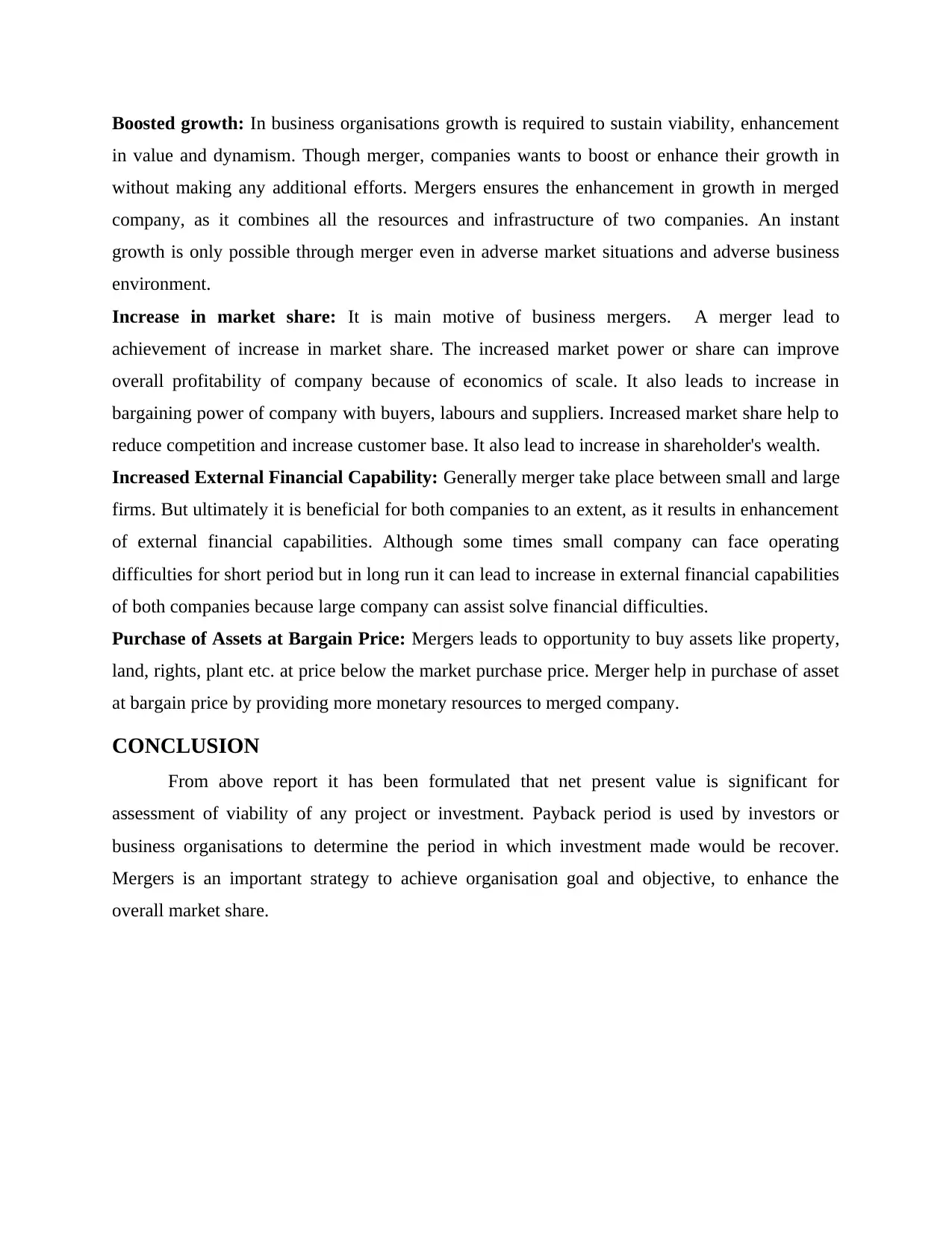
Boosted growth: In business organisations growth is required to sustain viability, enhancement
in value and dynamism. Though merger, companies wants to boost or enhance their growth in
without making any additional efforts. Mergers ensures the enhancement in growth in merged
company, as it combines all the resources and infrastructure of two companies. An instant
growth is only possible through merger even in adverse market situations and adverse business
environment.
Increase in market share: It is main motive of business mergers. A merger lead to
achievement of increase in market share. The increased market power or share can improve
overall profitability of company because of economics of scale. It also leads to increase in
bargaining power of company with buyers, labours and suppliers. Increased market share help to
reduce competition and increase customer base. It also lead to increase in shareholder's wealth.
Increased External Financial Capability: Generally merger take place between small and large
firms. But ultimately it is beneficial for both companies to an extent, as it results in enhancement
of external financial capabilities. Although some times small company can face operating
difficulties for short period but in long run it can lead to increase in external financial capabilities
of both companies because large company can assist solve financial difficulties.
Purchase of Assets at Bargain Price: Mergers leads to opportunity to buy assets like property,
land, rights, plant etc. at price below the market purchase price. Merger help in purchase of asset
at bargain price by providing more monetary resources to merged company.
CONCLUSION
From above report it has been formulated that net present value is significant for
assessment of viability of any project or investment. Payback period is used by investors or
business organisations to determine the period in which investment made would be recover.
Mergers is an important strategy to achieve organisation goal and objective, to enhance the
overall market share.
in value and dynamism. Though merger, companies wants to boost or enhance their growth in
without making any additional efforts. Mergers ensures the enhancement in growth in merged
company, as it combines all the resources and infrastructure of two companies. An instant
growth is only possible through merger even in adverse market situations and adverse business
environment.
Increase in market share: It is main motive of business mergers. A merger lead to
achievement of increase in market share. The increased market power or share can improve
overall profitability of company because of economics of scale. It also leads to increase in
bargaining power of company with buyers, labours and suppliers. Increased market share help to
reduce competition and increase customer base. It also lead to increase in shareholder's wealth.
Increased External Financial Capability: Generally merger take place between small and large
firms. But ultimately it is beneficial for both companies to an extent, as it results in enhancement
of external financial capabilities. Although some times small company can face operating
difficulties for short period but in long run it can lead to increase in external financial capabilities
of both companies because large company can assist solve financial difficulties.
Purchase of Assets at Bargain Price: Mergers leads to opportunity to buy assets like property,
land, rights, plant etc. at price below the market purchase price. Merger help in purchase of asset
at bargain price by providing more monetary resources to merged company.
CONCLUSION
From above report it has been formulated that net present value is significant for
assessment of viability of any project or investment. Payback period is used by investors or
business organisations to determine the period in which investment made would be recover.
Mergers is an important strategy to achieve organisation goal and objective, to enhance the
overall market share.
⊘ This is a preview!⊘
Do you want full access?
Subscribe today to unlock all pages.

Trusted by 1+ million students worldwide
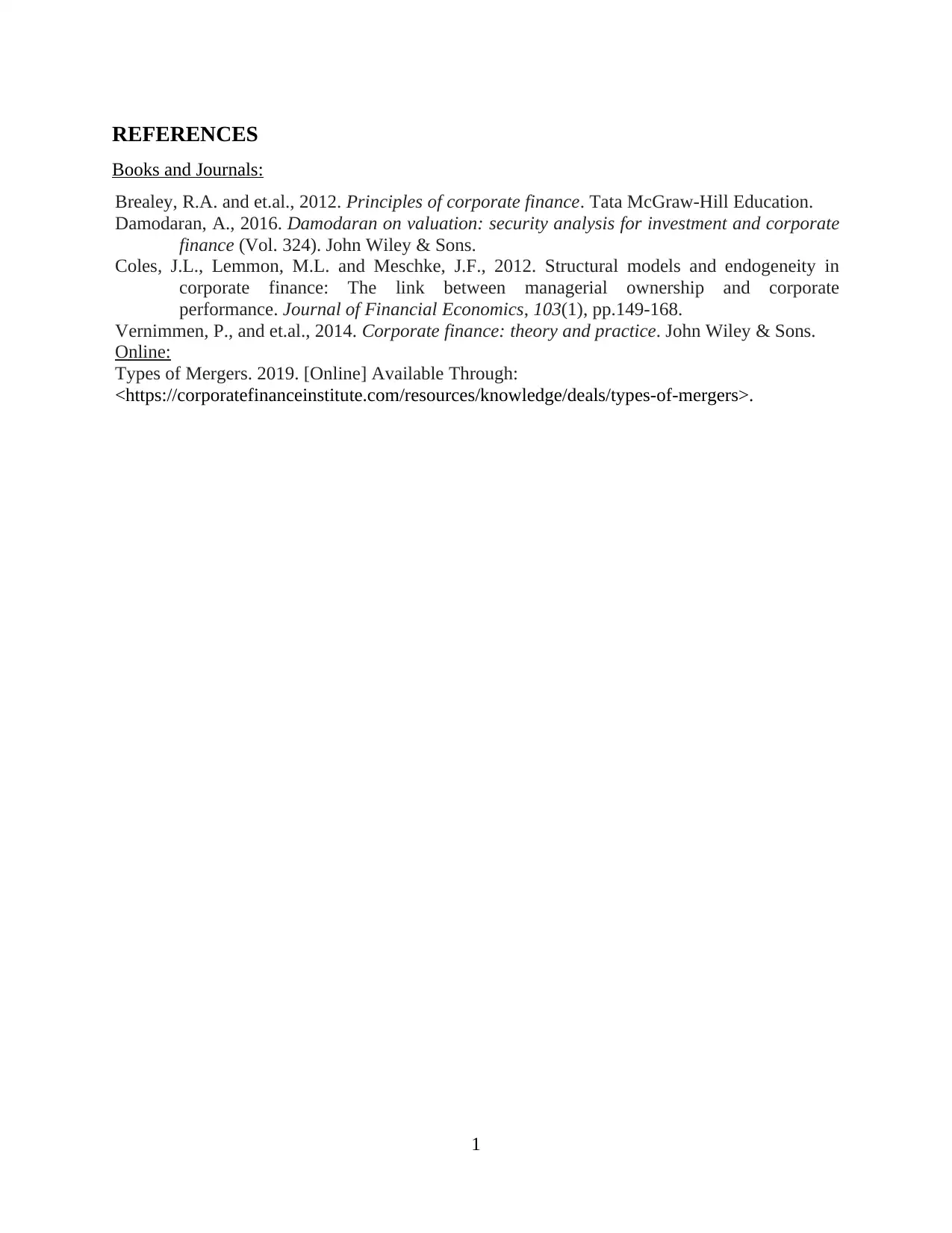
REFERENCES
Books and Journals:
Brealey, R.A. and et.al., 2012. Principles of corporate finance. Tata McGraw-Hill Education.
Damodaran, A., 2016. Damodaran on valuation: security analysis for investment and corporate
finance (Vol. 324). John Wiley & Sons.
Coles, J.L., Lemmon, M.L. and Meschke, J.F., 2012. Structural models and endogeneity in
corporate finance: The link between managerial ownership and corporate
performance. Journal of Financial Economics, 103(1), pp.149-168.
Vernimmen, P., and et.al., 2014. Corporate finance: theory and practice. John Wiley & Sons.
Online:
Types of Mergers. 2019. [Online] Available Through:
<https://corporatefinanceinstitute.com/resources/knowledge/deals/types-of-mergers>.
1
Books and Journals:
Brealey, R.A. and et.al., 2012. Principles of corporate finance. Tata McGraw-Hill Education.
Damodaran, A., 2016. Damodaran on valuation: security analysis for investment and corporate
finance (Vol. 324). John Wiley & Sons.
Coles, J.L., Lemmon, M.L. and Meschke, J.F., 2012. Structural models and endogeneity in
corporate finance: The link between managerial ownership and corporate
performance. Journal of Financial Economics, 103(1), pp.149-168.
Vernimmen, P., and et.al., 2014. Corporate finance: theory and practice. John Wiley & Sons.
Online:
Types of Mergers. 2019. [Online] Available Through:
<https://corporatefinanceinstitute.com/resources/knowledge/deals/types-of-mergers>.
1
1 out of 10
Related Documents
Your All-in-One AI-Powered Toolkit for Academic Success.
+13062052269
info@desklib.com
Available 24*7 on WhatsApp / Email
![[object Object]](/_next/static/media/star-bottom.7253800d.svg)
Unlock your academic potential
Copyright © 2020–2025 A2Z Services. All Rights Reserved. Developed and managed by ZUCOL.





